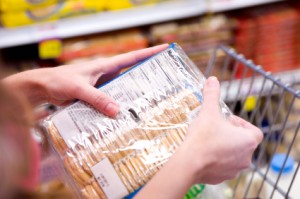When I first embarked on my gluten free diet, I was already used to reading food labels, but I was always scanning for healthy ingredients, not necessarily for hidden or masked items. Nor was I trying to determine if what was listed on the label was something I had to question as to its truthfulness. I believed the label – if it stated that it didn’t have GMO’s or was MSG-free, I believed them. Also, if I see a label now that states that it’s gluten free, then I believe it as well. Well, there’s been evidence that some companies have stated that their products are gluten free when they really weren’t.
In late 2008, an investigation revealed that certain gluten free products manufactured by Wellshire Farms (and specifically marketed to children) were mislabeled. A couple of children even developed anaphylaxis after they ate the mislabeled food and required hospitalization. Additionally, many children with celiac disease were sickened. So can we trust the labels when they say that they are gluten free?
Currently in the United States, there is no definition for the use of the term “gluten-free” with regard to food labeling. It comes down to how many parts per million of gluten can reside in a food product. The FDA regulation to define “gluten-free” for volunteer labeling of foods is expected to be published in the third quarter of 2012. Still haven’t heard the latest on this one. The regulation states that a food product with less than 20 parts per million (ppm) can be labeled as gluten-free. The proposal, which can be found here,
states that a gluten-free label would mean a food does not contain:
- Any ingredient that is a prohibited grain, such as wheat, rye, barley, or their derivatives.
- Any ingredient derived from a prohibited grain that has not been processed to remove gluten, such as barley malt extract or malt vinegar.
- Any ingredient derived from a prohibited grain that has been processed to remove gluten if 20 ppm or more gluten remains in the food, such as wheat starch or modified food starch.
- 20 ppm or more of gluten.
Many celiac organizations generally agree that 20 ppm is a safe threshold for people with celiac disease; many countries have adopted gluten-free standards at or below 20 ppm.
The bottom line is you need to keep reading the labels. Keep looking for items that you aren’t sure of and contact the company before you eat their product. Ask the company in question about how they prevent cross contamination. Ask them if they process their food in dedicated gluten-free facilities. It still takes a lot of diligence but hopefully there will be a time when there’s accountability behind every gluten free claim.

Since my gluten-free regimen began after diagnosis for intolerance; I’ve sought nutritional direction and assistance with finding a new path for cooking. However, baking has never been high on my list of favorites, mostly because my own consumption of wheat flour-based desserts was never enjoyable and their creation just as unsatisfying. In this book, the ingredients, steps, methods and results are all TOP NOTCH. Great attention and just-enough explanation has helped me create very delectable cakes and pies that I would have never bothered attempting before. As with most recipe books, the paperback version is void of helpful photos. However, it has given my family and friends another glance into the challenges of eating gluten-free; it’s great for sharing recipes with those who’d cook for those with intolerances/allergies.
Hi Youichi, Thanks for the comment and I’m happy to hear that you’ve found some recipes that allow you to bake some yummy cakes and pies that are gluten-free for your friends and family to enjoy!
Shelley
Agree with you. Food labels should contain clear and understandable information. Also, they should not contain ingredients like Added Sugars or Added fats. They should clearly write what they have in their product. Added fats, in no terms, tell what kind of fats it includes. Trans fats is bad while polyunsaturated and monounsaturated fats are good for health. So they should be labelled appropriately.